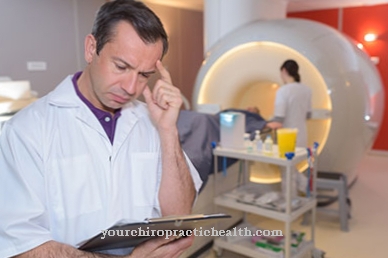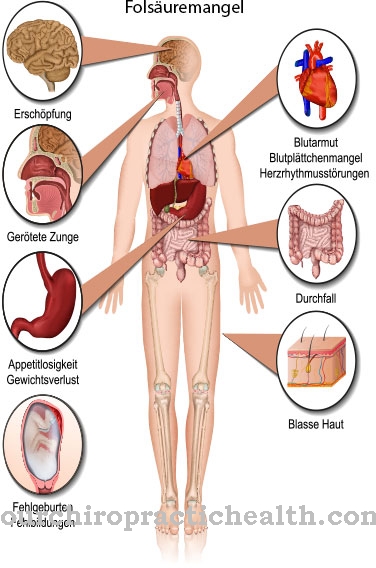The Portal vein thrombosis is a disease that does not usually lead to symptoms immediately and is therefore characterized by a rather insidious course. In the acute state, immediate action is required for portal vein thrombosis.
What is portal vein thrombosis?

© maniki - stock.adobe.com
The designation Portal vein thrombosis is a compound word that consists of a portal vein and thrombosis. In connection with the localization of the thrombosis, the portal vein is affected in this clinical picture. The portal vein is a special blood vessel that is responsible for carrying blood to the liver.
In medicine, a thrombosis is used when, as in the case of portal vein thrombosis, the portal vein is blocked by a so-called clot, which becomes lodged in the vessel and impairs or prevents blood supply or drainage. Portal vein thrombosis is a rare form of thrombosis, which is already known from other cardiovascular diseases.
causes
To a Portal vein thrombosis It usually occurs when there are already unfavorable underlying diseases. These are the growth of tumors in the pancreas or in the tissues of the liver.
Another cause of portal vein thrombosis can be an inflammatory process in the pancreas. Like hepatitis, this is accompanied by swelling of the affected organ and can lead to portal vein thrombosis. People who suffer from an increased tendency to form blood clots, are "dehydrated" from not drinking enough fluids, or have become poisoned, can also develop portal vein thrombosis.
This also applies to patients who take certain medications and live with an increased risk of developing a venous thrombosis. A portal vein thrombosis can also be favored by an existing pregnancy or a loss of liver function (liver cirrhosis).
Symptoms, ailments & signs
In most cases, portal vein thrombosis remains without symptoms. It is often only noticed when complications arise, which can often be life-threatening. Some patients gradually develop varicose veins in the esophagus or stomach due to portal hypertension. This increases the risk of esophageal or stomach bleeding.
This can cause vomiting of blood or so-called tarry stools. When bleeding in the upper digestive organs, black, tarry, and foul-smelling stools typically appear. The spleen is often greatly enlarged. In some patients this leads to painful swelling of the abdomen. Often meteorism and ascites then occur.
The blood congestion can also cause disorders in the intestine. Sometimes diarrhea and the so-called subileus symptoms occur. The subileus symptoms are characterized by the fact that the intestinal contents are only moved forward to a limited extent. There is a back pressure towards the mouth. This backlog is noticeable through nausea and a feeling of fullness. Intestinal cramps and colic also occur.
Food components are only insufficiently absorbed. The subileus represents the preliminary stage of an ileus, i.e. an intestinal obstruction. However, portal vein thrombosis is rarely as dramatic. As already mentioned, there are usually no symptoms at all because a large bypass cycle develops over the course of a few weeks and months. Any existing upper abdominal complaints and enlargement of the spleen then gradually decrease.
Diagnosis & course
For a targeted, precise detection of the Portal vein thrombosis there are very different methods available to doctors. These are used in particular after the patient has been assessed if they describe their symptoms, some of which are unspecific.
The individual process technologies for diagnosing portal vein thrombosis are based on proven and highly complex medical technology, which are suitable as ultrasound of the upper abdomen, computer and magnetic resonance tomography as well as a so-called color Doppler examination. These individual procedures in portal vein thrombosis are completed by extensive tests in the laboratory. These concern, for example, the so-called liver values in the serum and the determination of the coagulation factors in the plasma.
The course of portal vein thrombosis is accompanied by pain and swelling of the upper abdomen. Diarrhea, persistent bloating and nausea, in rare cases vomiting, accompany the portal vein thrombosis.
Complications
The portal vein thrombosis causes no symptoms in most cases. Complications usually arise from the underlying diseases. However, water can accumulate in the abdominal cavity. Furthermore, varicose veins appear in the esophagus and stomach, which in unfavorable cases can even burst and cause profuse bleeding. Since the portal vein is blocked, the blood pressure also rises in it.
This local increase in blood pressure can cause the spleen to enlarge and tear very much. However, a portal vein thrombosis often has a very severe impact on liver function if it is no longer supplied with enough blood. Most complications, as mentioned earlier, are caused by the underlying medical conditions.
A portal vein thrombosis, which is triggered by liver cirrhosis, is much more likely to lead to esophageal and stomach bleeding or ascites. Otherwise, ascites is not very common with other causes. Therefore, a portal vein thrombosis in connection with cirrhosis of the liver is a life-threatening complication.
Severe pancreatitis, a malignant pancreatic tumor, or kidney cancer can also cause portal vein thrombosis. Again, the underlying diseases cause the majority of complications. The diagnosis of the underlying diseases is therefore very important in order to be able to effectively treat a complication that occurs as part of a portal vein thrombosis.
When should you go to the doctor?
People who suffer from a general feeling of illness, malaise and restlessness should consult a doctor. A steady decrease in resilience, insomnia or the vague feeling that something might be wrong should be discussed with a doctor. With a portal vein thrombosis there is a gradual increase in symptoms. Symptoms are free for a long time. Since the course of the disease can still be fatal, a doctor should be seen the first time you notice irregularities. Vomiting of blood, dizziness, tightness in the body, swelling or disturbances of the blood flow should be examined and treated.
A doctor is required in the event of abnormalities in the digestive tract, changes in the complexion or peculiarities of the excretions. Cramps, pain and a loss of appetite indicate a health impairment. A doctor is needed if there is constipation, a feeling of fullness, or a decrease in physical performance. In the event of nausea, increased body temperature, bad breath or unwanted weight loss, a visit to a doctor is advisable. If there are changes in behavior, increased irritability or bleeding when using the toilet, a doctor must be consulted as soon as possible. A rescue service is to be alerted as soon as there are disturbances of consciousness. In these cases, a life-threatening condition is present that must be treated immediately.
Treatment & Therapy
Treatment of the Portal vein thrombosis opens up different variants in the course of modern medical procedures and interventions. In portal vein thrombosis it is fundamental that the same therapy is used that is also adequate for another thrombosis.
In this regard, it is primarily a matter of dissolving the thrombus and clearing the portal vein again. This happens in portal vein thrombosis, which can affect either the entire portal vein or only a part of it, through carefully selected drugs. These are also referred to as anticoagulants in thrombosis tharpy and are also based on marcumar and heparin in portal vein thrombosis.
In contrast to thromboses, which can develop in various other blood vessels in the body, there is no risk of pulmonary embolism with a portal vein thrombosis. Nevertheless, it is important to act as quickly as possible in order to avoid damage to the liver tissue due to insufficient blood flow. In addition, the treatment of portal vein thrombosis is based equally on alleviating the symptoms and causes of the underlying diseases.
Outlook & forecast
A thrombosis, regardless of the location, is always a worrying event. The prognosis of portal vein thrombosis is only positive if the blood clot is noticed quickly and can be resolved promptly. If the patient becomes chronic, the prognosis is less good.
The problem is that portal vein thrombosis can be symptom-free. It is therefore often not noticed. If there are unspecific symptoms such as abdominal pain or fever, it is discovered earlier. However, the discovery often happens by chance. This can lead to a delayed start of treatment. There is a risk that some of those affected will develop intestinal necrosis. This can subsequently lead to peritonitis, which is fatal due to multiple organ failure.
With portal vein thrombosis, which has already become chronic, cavernous changes can occur with subsequent portal hypertension. The prognosis deteriorates significantly if bleeding from torn varices is a complication. Since a portal vein thrombosis becomes more likely with certain pre-existing diseases or hereditary components, doctors should exercise particular care during check-ups.
In only 10-40 percent of those affected, portal vein thrombosis can be remedied by therapy with blood coagulants for several months. The unfavorable prognosis for the rest of those affected can be derived from this. With early diagnosis and early start of treatment, the chances are still best.
prevention
Preventing a Portal vein thrombosis lies in the fact that the causal diseases are treated accordingly. In addition, if these pre-existing conditions are present, it is important to have a regular medical check-up and, above all, to pay close attention to the coagulation factors.
According to a laboratory finding, these should not be above the normally permissible parameter. Only in this way can a meaningful prevention against portal vein thrombosis be initiated. In addition, it is important to drink enough to avoid portal vein thrombosis. This particularly affects older people, who often suffer from a reduced feeling of thirst.
Aftercare
Follow-up care measures are very limited in many cases of portal vein thrombosis, as the disease is usually recognized late and is therefore treated in many cases at an advanced stage. Those affected should therefore consult a doctor at the first signs and symptoms of the disease so that there are no further complications or other complaints.
As a rule, the portal vein thrombosis cannot heal itself. Most people affected by this disease are dependent on various medications. The correct dosage and regular intake should always be observed in order to relieve the symptoms permanently and correctly.
Likewise, those affected should always consult a doctor first in the event of uncertainties, questions or severe side effects in order to prevent further complications. In the case of portal vein thrombosis, strenuous activities or physical activity should be avoided in order not to unnecessarily burden the body.
Most patients depend on the care and support of their own families in their everyday lives. In many cases this can also prevent depression and other mental disorders. It is not uncommon for portal vein thrombosis to drastically reduce the life expectancy of the person affected.
You can do that yourself
Once this diagnosis is made, it is important to find out how this rare form of thrombosis came about. What diseases did they cause? The answer to this question determines how the therapy proceeds, because the portal vein thrombosis itself often causes little or no symptoms. However, any underlying medical conditions can be serious and complicated.
Patients with portal vein thrombosis should watch their blood pressure as it may be increased due to the clogged portal vein. Even if diets that are gentle on the liver are no longer recommended these days, it makes sense for portal vein thrombosis patients to avoid alcohol and foods that are too fatty. Instead of animal fats, oils with high-quality omega-3 fatty acids such as linseed or walnut oil are recommended. “Empty” carbohydrates such as white bread, pasta and sweets should be avoided in the long term. If the patient is overweight, it would be desirable to reduce this excess weight and achieve normal weight. If varicose veins have been detected in the stomach along with portal vein thrombosis, smaller meals are recommended several times a day, as they are easier to digest than three large ones.
Furthermore, everything that relieves stress is helpful. This includes regular rest periods as well as daily exercise in the fresh air. Gentle sports such as yoga, Reiki, Tai Chi or Qi Gong also help to relieve stress.




.jpg)






















